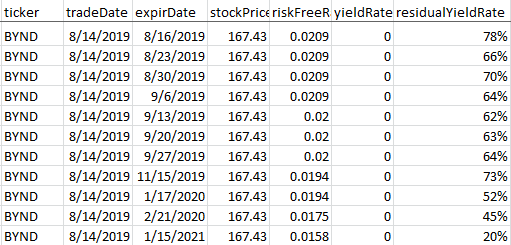Indicators
Wednesday, August 14th 2019
Why Don't Call and Put Implied Volatilities Match?
$BYND is a hard-to-borrow stock where the implied volatilities can get mismatched between the calls and puts unless you solve to the implied borrow or residual rate.
Summary
Call and put implied volatilities may not match due to poor assumptions in the options pricing model, such as incorrect dividend or interest rate inputs. In the case of hard-to-borrow stocks like BYND, a residual yield rate can be created to align the calls and puts, with the market's implied borrow rate serving as the residual rate. A systematic way to calculate borrow allows for comparison with the implied borrow rate and the ability to graph the borrow, which can spike when the stock runs up.
There are many situations where call and put implieds do not match up. Usually this has to do with a poor assumption in the inputs to the options pricing model, like which dividends or interest rates to use.
Take this case study presented by Robert Morse on EliteTraders site. "BYND is very hard to borrow. The Sept ATM calls are 38.11 and the puts are 82.95. There is still put-call parity but the default rate of 1.68% (10 year T-bill). That is not accurate for this symbol. I'd have to put in my cost to short it. Then add extra because you can't get a locate."

Here's how we handle this situation. We create a residual yield rate to line up the calls and puts. For BYND the residual rate is the market's implied borrow rate.

For Robert's example, the Sep implied borrow is 63%. This lines up the call and put IVs to about a 55%.

When you have a systematic way to calculate borrow, you can compare (as Robert says) the implied borrow to your borrow rate.
You can also graph the borrow.

We graph the constant maturity borrow at 30 days and 2 years to expiration interpolated. Above is the borrow at 30 days.
Notice how borrow spikes when the stock runs up.
The residual rates data are available in our Data API that you can trial here.
The graph is a new feature in Wheel that you can trial here.
Disclaimer:
The opinions and ideas presented herein are for informational and educational purposes only and should not be construed to represent trading or investment advice tailored to your investment objectives. You should not rely solely on any content herein and we strongly encourage you to discuss any trades or investments with your broker or investment adviser, prior to execution. None of the information contained herein constitutes a recommendation that any particular security, portfolio, transaction, or investment strategy is suitable for any specific person. Option trading and investing involves risk and is not suitable for all investors.
All opinions are based upon information and systems considered reliable, but we do not warrant the completeness or accuracy, and such information should not be relied upon as such. We are under no obligation to update or correct any information herein. All statements and opinions are subject to change without notice.
Past performance is not indicative of future results. We do not, will not and cannot guarantee any specific outcome or profit. All traders and investors must be aware of the real risk of loss in following any strategy or investment discussed herein.
Owners, employees, directors, shareholders, officers, agents or representatives of ORATS may have interests or positions in securities of any company profiled herein. Specifically, such individuals or entities may buy or sell positions, and may or may not follow the information provided herein. Some or all of the positions may have been acquired prior to the publication of such information, and such positions may increase or decrease at any time. Any opinions expressed and/or information are statements of judgment as of the date of publication only.
Day trading, short term trading, options trading, and futures trading are extremely risky undertakings. They generally are not appropriate for someone with limited capital, little or no trading experience, and/ or a low tolerance for risk. Never execute a trade unless you can afford to and are prepared to lose your entire investment. In addition, certain trades may result in a loss greater than your entire investment. Always perform your own due diligence and, as appropriate, make informed decisions with the help of a licensed financial professional.
Commissions, fees and other costs associated with investing or trading may vary from broker to broker. All investors and traders are advised to speak with their stock broker or investment adviser about these costs. Be aware that certain trades that may be profitable for some may not be profitable for others, after taking into account these costs. In certain markets, investors and traders may not always be able to buy or sell a position at the price discussed, and consequently not be able to take advantage of certain trades discussed herein.
Be sure to read the OCCs Characteristics and Risks of Standardized Options to learn more about options trading.
Related Posts



